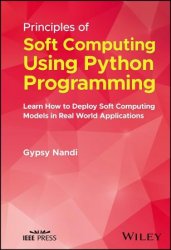 Название: Principles of Soft Computing Using Python Programming: Learn How to Deploy Soft Computing Models in Real World Applications
Название: Principles of Soft Computing Using Python Programming: Learn How to Deploy Soft Computing Models in Real World ApplicationsАвтор: Gypsy Nandi
Издательство: Wiley-IEEE Press
Год: 2024
Страниц: 348
Язык: английский
Формат: pdf (true), epub
Размер: 17.6 MB
An accessible guide to the revolutionary techniques of Soft Computing.
Soft computing is a computing approach designed to replicate the human mind's unique capacity to integrate uncertainty and imprecision into its reasoning. It is uniquely suited to computing operations where rigid analytical models will fail to account for the variety and ambiguity of possible solutions. As Machine Learning and Artificial Intelligence become more and more prominent in the computing landscape, the potential for soft computing techniques to revolutionize computing has never been greater.
Principles of Soft Computing Using Python Programming provides readers with the knowledge required to apply soft computing models and techniques to real computational problems. Beginning with a foundational discussion of soft or fuzzy computing and its differences from hard computing, it describes different models for soft computing and their many applications, both demonstrated and theoretical. The result is a set of tools with the potential to produce new solutions to the thorniest computing problems.
Soft computing is a vital tool used for performing several computing operations. It uses one or more computational models or techniques to generate optimum outcomes. To understand this concept, let us first clarify our idea about computation. In any computation operation, inputs are fed into the computing model for performing some operations based on which results are accordingly produced. In the context of computing, the input provided for computation is called an antecedent, and the output generated is called the consequence.
Traditional Machine Learning is a well-known, conventional approach used for solving simpler tasks that have limited data, while Deep Learning is a recent, advanced approach used for solving complex tasks involving large amounts of data. Some of the common examples of machine learning techniques include support vector machines, decision trees, random forests, linear regression, and logistic regression. Deep learning is a subset of machine learning that uses artificial neural networks (discussed in previous chapter) to learn from given dataset and make predictions to obtain result. Some of the common applications of Deep Learning involve speech recognition, image recognition, and natural language processing (NLP).
Readers of Principles of Soft Computing Using Python Programmingwill also find:
Each chapter accompanied with Python codes and step-by-step comments to illustrate applications
Detailed discussion of topics including artificial neural networks, rough set theory, genetic algorithms, and more
Exercises at the end of each chapter including both short- and long-answer questions to reinforce learning
Principles of Soft Computing Using Python Programmingis ideal for researchers and engineers in a variety of fields looking for new solutions to computing problems, as well as for advanced students in programming or the Computer Siences.
Скачать Principles of Soft Computing Using Python Programming: Learn How to Deploy Soft Computing Models in Real World Applications